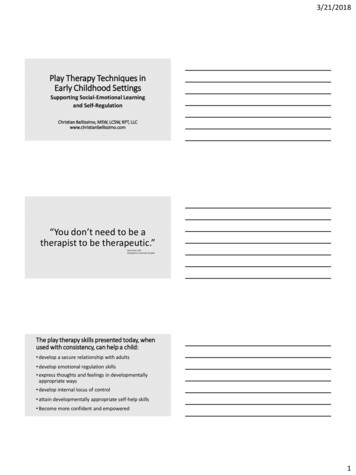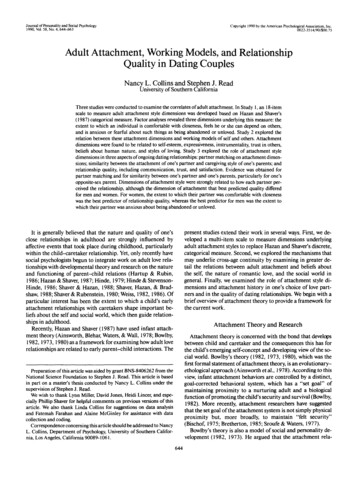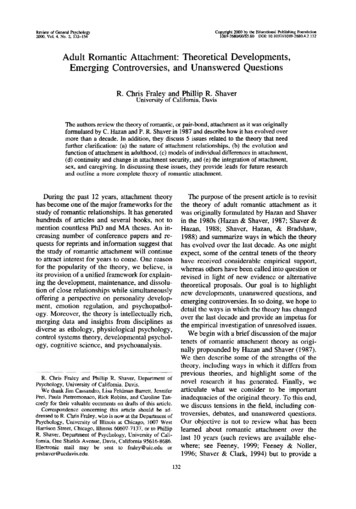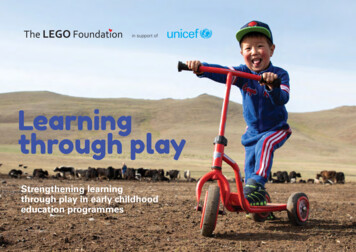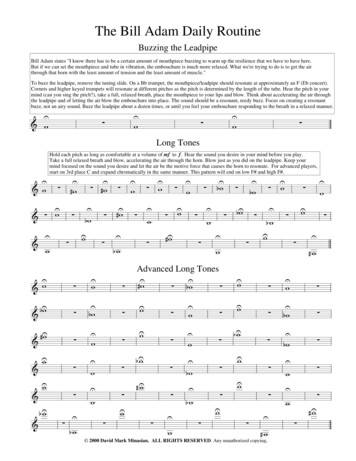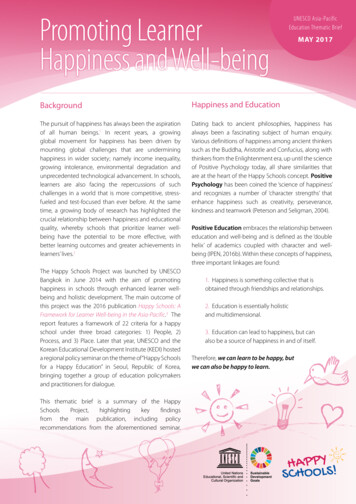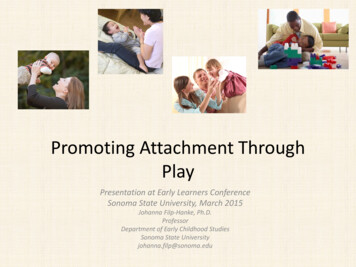
Transcription
Promoting Attachment ThroughPlayPresentation at Early Learners ConferenceSonoma State University, March 2015Johanna Filp-Hanke, Ph.D.ProfessorDepartment of Early Childhood StudiesSonoma State Universityjohanna.filp@sonoma.edu
ies-film-review
Bowlby and Ainsworth Attachment provides the foundation forhealthy, intimate relationships. “Attachment is an inborn system in the brainthat evolves in ways that influence andorganize motivational, emotional and memoryprocesses with respect to significantcaregiving figures.” (Bowlby, 1969)
Why do we care about attachment? Attachment provides the early foundation forthe working model for how relationshipswork, and what you can expect.– Can you depend on people?– Can you trust them? Facilitates development of emotionalregulation, social skills, and empathy Secure attachment is a resiliency factor
Secure attachment promotes Flexible self-regulationProsocial behaviorEmpathyPositive sense of emotional well-beingand self-esteemCoherent life-storySource: Dan 6.pdf
Attachment and brain development
What is needed for synaptogenesisto take place? Serve and return interactions with humanbeings
Still Face ExperimentDr. Edward TronickUniversity of Massachussets Boston
Attachment and mirror neurons“Mirror neurons are a type of brain cell thatrespond equally when we perform an actionand when we witness someone else performthe same action.Mirror neurons repond not only to otherpeople’s actions and emotions, but also to theintent behind these actions.” (Winerman,2005,p. 48)
Human connections shape neuralconnections“Our brains are extremely social. Areas involved in self-regulationoverlap with those involved in interpersonal communication andplasticity”“How one brain interacts with another has important effects on howthe brain functions: Social interactions are one of the mostpowerful forms of experience that help shape how the brain givesrise to the mind “Source: Dan 6.pdf
Attachment and neurotransmsitters Infants who experience secure attachment:secretion of neurotransmitters, producessense of well being Trauma or neglect can reduce secretion ofneurotransmittersGonzalez-Mena and Widmeyer (2015)
Brain Development and EarlyChildhood AdversityPhotocredit: 6631501n.jpg
We need to create conditions that reestablishthe Circle of Security
Attachment creates theCircle of Securityhttp://circleofsecurity.net
The unique role of infant/toddler andpreschool Teachers“Teachers of infants and toddlers have anamazing opportunity to build a healthyattachment with each baby in their care. Theyalso have the unique role of helping tosupport a healthy, lifelong attachmentbetween babies and their parents”(Gillespie and Hunter, 2011, p. 62)
Double role Creating healthy attachment with youngchildren in our care Supporting families in their attachment withtheir children
What strategies do you use to createhealthy attachments in your center? Understand uniqueness of each childConsistency and responsivenessEncourage laughter and playCare for yourself
How can you support parent/familychild attachment Encourage parents to read and understandsignals baby sends, and respond appropriately Help parents/family caregiver recognize andfeel that they are the most important peopleto the baby Show parents how they can connect with thebaby through humor and play
Attachment Play“Playful activities can reduce stress, strengthenattachment, and solve behavior problemswhile bringing laughter and joy to you and thechildren.” (Solter, 2015, p. 3)
The Importance of Mind-Mindednessin AttachmentParents who are mind-minded act as if a babycan communicate and understands what wesay to them. They are attuned to the baby andfollow their gaze and try to see what the babyis interested in. They observe the baby andimitate his/her actions. They tend to commenton what they think the baby is feeling,interested in, or seeing. (Meins, 2013)
Attachment PlaySolter, A.J. (2013) Attachment Play How to solvechildren’s behavior problems with play,laughter and connection. Goleta, CA: ShiningStar Press
Attachment play is a special kind ofplay Interactive, strengthens connectionsOften involves laughterCan be child or adult initiatedDoes not require special equipmentCan take place anywhere, anytimeIncludes many familiar activitiesSolter (2015)
Attachment play is not Permissive disciplineDoes not teach aggression to childrenIs not a form of teasingDoes not involve competitionDoes not have any set rulesSolter (2015)
General guidelines Follow the child’s lead, remain flexible– Recognize indirect invitations– Be sensitive to response: does the child withdraw? Participate? This is not the time to teach or correct– Try and accept everything, unless if it’s hurtful toward the child, anotherperson, animal, or the environment If your child is laughing you are on the right track– Change activities if child appears to be afraid Teasing is not attachment play– Children may laugh out of embarrassment– Imitative play may turn into teasing, need to be sensitive Avoid ticklingDon’t try attachment play when the child is cryingPUT YOUR SMART PHONE AWAY, BE CONNECTED TO THE CHILDSolter (2015)
Different forms of attachment play:Solter 2015 Nondirective child centered play Symbolic play Helps feelings of being cared forActivities with body contact Helps children feel power, in controlRegression games Helps deal with daily separationsPower-reversal games Helpful for shy childrenSeparation games Promotes sense of predictability, powerNonsense play Useful to deal with traumaContingency play Promotes security, trust, reduces stressPromotes feelings of belonging, being valuedCooperative games and activities Helps deal with feelings of envy, competition, rivalry
ReferencesCenter on the Developing Child. Harvard University. Multimedia resources. Online timedia/Gillespy, L. and Hunter, A. (2011) Creating healthy attachments to the babies in your care. Young Children, 62-63.Gonzalez-Mena, J. & Widmeyer Eyer, D, (2015) Infants, toddlers, and caregivers. A curriculum of respectful, responsive,relationship-based care and education. New York, NY: McGraw-Hill Education.Meins, E. (2013) Sensitive attunement to infants’ internal states: operationalizing the construct of mind-mindedness.Attachment and Human Development, 15, (5-6), 524-544Siegel, Dan. (n.d.) Human attachment: Relationships, mind, and brain. Online fSolter, A.J. (2013) Attachment Play. How to solve children’s behavior problems with play, laughter , and connection.Goleta, CA: Shining Star Press.The Center on the Social and Emotional Foundation for Early Learning (n.d.). Make the Most of Playtime. Online athttp://csefel.vanderbilt.edu/documents/make the most of playtime2.pdf
Different forms of attachment play: Solter 2015 Nondirective child centered play Promotes security, trust, reduces stress Symbolic play Useful to deal with trauma Contingency play Promotes sense of predictability, power Nonsense play Helpful for shy childr

